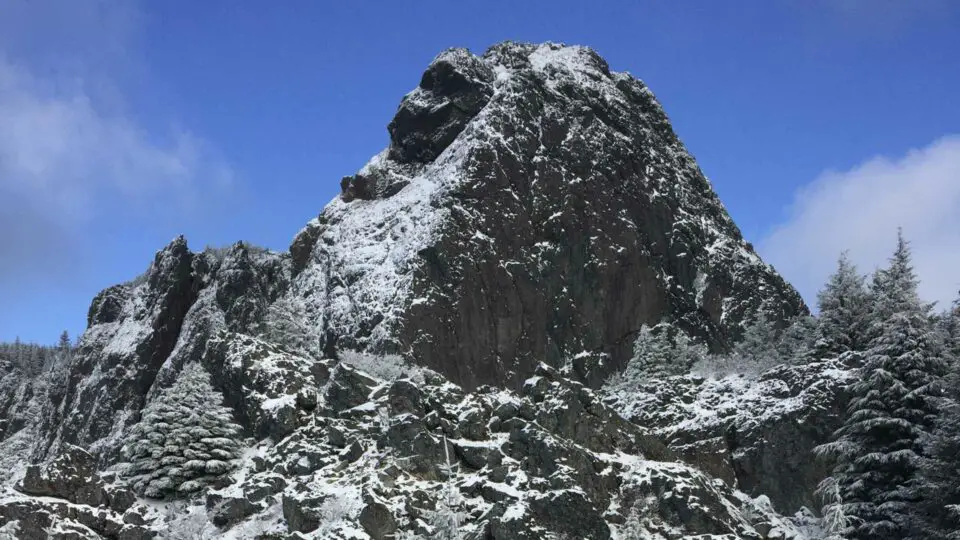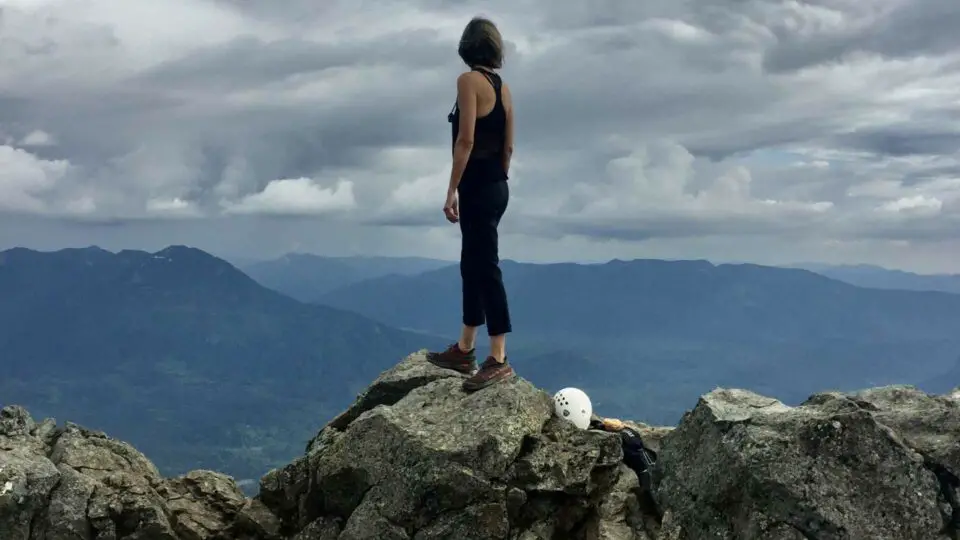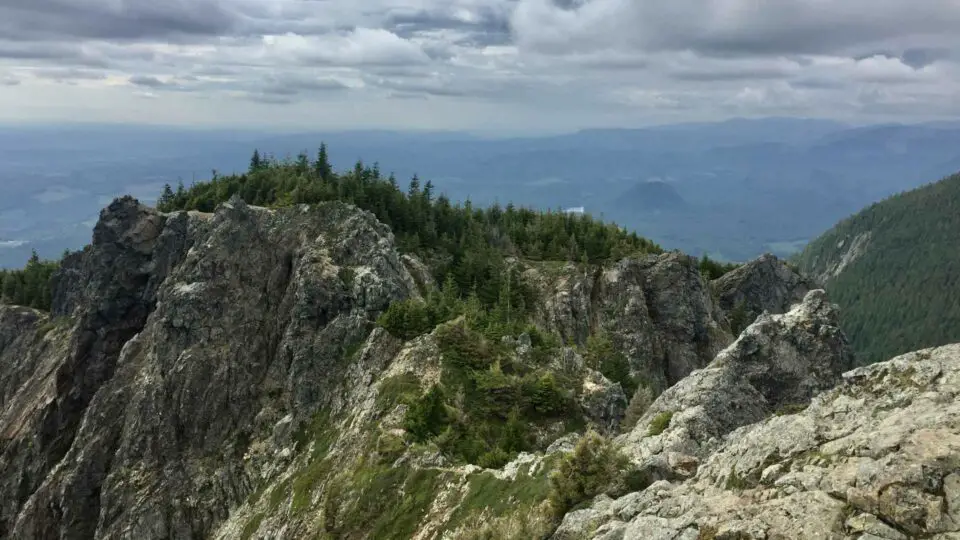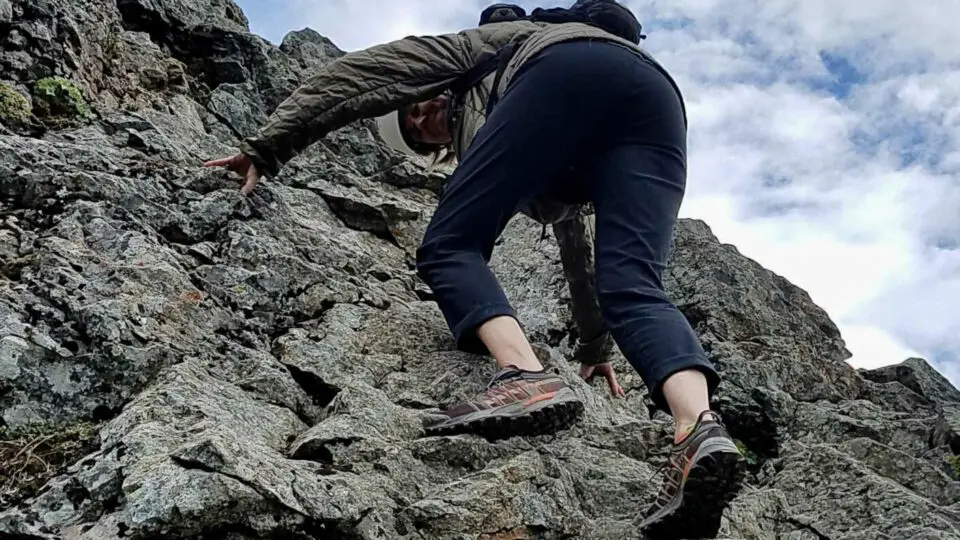Slippery slope here, no pun intended, as we talk about the Haystack, because that nubbin on top of Mount Si crosses the line from hike to climb. It’s a Class 3 with exposure, and falls have resulted in numerous deaths. It’s a don’t-look-down, three points of contact, mildly dizzying 150 feet or so that starts as a gully then wraps around the back and side and finally tops out onto a small collection of rocks of suitable size for a small handful of people to sit or stand about. It is in no way, shape, or form a “hike.”
But it seemed remiss to have various trip reports and info about Mount Si and not at least acknowledge the Haystack in a separate piece. Which fits, since it too is sort of a separate piece. Its 150 feet look nothing like the 3000 feet of gain it takes to reach its base, nothing like the previous nearly four miles of simple dirt path and dense fir forest. No, it rises from the top of the mountain like a shark’s fin, gray and pointy. Bare rock. 99% of people when they say they hiked Mount Si, they don’t mean they also climbed to the top of the Haystack, and that is acceptable. The Haystack is like a bonus. Little cherry on top that not everyone can or should indulge in.
Who Should Climb The Haystack?

If you’ve been scrambling around a bit and want a new goal, if you find that Snoqualmie Mountain and the boulder route up Granite Mountain no longer challenge you, or if you’ve been spending a lot of time in the climbing gym and want to take what you’ve done and see how it feels on real rock, the Haystack might be a perfect next step for you. If you have mastered the art of compartmentalizing your fear and being able stay logical, push through, and not panic, you might find this to be a good move forward in your development as a climber.
Who Shouldn’t Climb The Haystack?
Most people. If we’re talking about the Everyday Hiker — the one who gets vertigo on Mailbox, who doesn’t own an ice axe, who doesn’t like getting too close to the edge at Rattlesnake Ledge — most folks shouldn’t be up there. If you don’t have a helmet, don’t go up there. If you get skeeved out looking hundreds of feet down between your ankles with your tiptoes on tiny ledges and your sweaty hands holding on for dear life, this probably isn’t your jam. If you haven’t been climbing for long and aren’t confident and familiar with your abilities maybe wait. If you’re with your kids or dog, please don’t. This is an undertaking for people who have done some scrambling already and know their capacity both physically and mentally.
Once You’re Ready To Climb The Haystack
It’s probably a good idea to go with someone who has climbed it before and is familiar with the best way up. The first time I “tried” I got about halfway up the gully and then froze like a starfish pasted to the wall, clammy, breathing shallow and sharp, mind both racing and numb, arms and legs strewn about, hugging, clinging on for dear life as I couldn’t see a way up or down. I was frozen. Maybe not quite a real live panic attack but I was far from chill. I was alone and certain for a few moments there that I was just going to peel off and die, but somehow, shaking, sweating, I slithered back down and vowed to never do that again. But didn’t die, I tried again another day, sort of, and it was better, sort of. Then a couple years passed, and I had hiked (the rest of) Mount Si dozens of times but had put the Haystack so far on the back burner that I barely saw it when I looked around from the lower, accepted “summit” block (which is a fun beginner’s bouldering playground in its own right). And so after spending time in the climbing gym and developing not just my physical strength, agility, and skill, but also my mental control over the heebie-jeebies, I decided it was time to give it a try — this time with a friend who was intimately familiar with where the best holds were and could calmly talk me through it while leading the way.
Climbing The Haystack

The first 85% of the climb was completely comfortable. Still used three points of contact, but didn’t feel vertigo-y at all. As we rounded the corner on the far west side, there are about ten feet where looking down would be a really bad idea, unless you have Alex Honnold’s amygdala; it’s just nothingness all the way down, and I was aware of it, I could feel the nothingness, the complete lack of safety, knowing that if you so much as sneezed you’d land splat on i-90 five seconds later, but I was able to not look down and to use a trick I’d learned on other scrambles and on Mt. Hood’s Pearly Gates: look at your hands. Keeping my eyes on my hands and on the few feet above me helped me put the exposure in a separate box and set it way aside and out of my moment. I didn’t feel panicky, I didn’t pause once, I kept moving swiftly upwards, looking at my hands. I felt like a goat, or a gecko, I felt like I was built to move upward on rock, like my body knew what it was doing and did it well as long as my mind stayed out of it, which I had trained it to do. As we topped out, I burst out laughing and said, “is that it?” We sat up top and ate the Arby’s sandwiches that I had stuffed in my Camelbak, marveled at the view, the perfect temperature, the success of the ascent, and a while later turned around backwards to downclimb down. Same thing, just keep moving, don’t overthink, the holds are there, the rock is solid, and your body knows what to do. I didn’t even realize we had rounded the exposed corner until we were just past it; my eyes were on my hands, glancing briefly now and then to see where to go next, but mostly just feeling my way down intuitively and with the occasional “there’s a big hold for your left foot about six inches down” or “you’ve got this, move your hand a little to the right” I found myself back in the gully and almost but not quite able to turn around and walk down. I stayed downclimbing until I felt secure, a spot that may be a little different for everyone. Sometimes facing out just feels tippy, and the last thing I wanted was to have finally climbed this thing and then fall and knock a tooth out ten feet from done. And I can be pretty uncoordinated if I’m not paying attention, so for me, the facing in felt right. You do what feels right for you.
When To Climb The Haystack
When it is dry. This can’t be stressed enough. Even folks who clamber up and down the Haystack at lightning speed wouldn’t recommend doing it in rain or even fog. You want sticky. You want the soles of your shoes, often just the tiptoes, to grip. You want your hands to be able to support a decent amount of your weight as you rely on them to keep you grounded while moving your feet. You want to feel like you’re adhesive, and even the lightest mist makes rock feel completely different and is not recommended for any level of climber. Pros know that, and hopefully noobs aren’t cocky enough to think they can do it. Not to mention, if you do get cliffed out, a helicopter response is going to be severely hampered by fog or low clouds and you’d be putting ground SAR at risk if they have to climb up wet rock to get you and bring you down.
Some climbers, proficient in steep snow travel, do climb the Haystack in the snow but these are folks who are more Mountaineer than Hiker, who have used two ice tools, who might be using ice screws, who might be training for things like a winter climb of Mount Hood or the north face of Mt. Baker. Please operate within your comfort zone when debating a winter ascent of any peak.
Know Your Limits / Have Fun

If you’re new, which I assume you might be if you’re gathering info online, please please know your limits and go with a person experienced on this particular hunk of rock. And if you’re a little beyond Haystack-level and are reading this thinking it sounds like overkill for a simple Class 3 that you bang out after work twice a week, consider some of the folks that you see out there doing things they have no business doing and either getting injured or having to be rescued. Mount Si is one of the most popular hikes in the state, and with that kind of traffic, you get a lot of non-climbers trying to climb things they shouldn’t.
So just know which camp you’re in, and if you’re a decent climber, by all means have at it and enjoy the heck out of it! It’s a short but very satisfying scramble on very sturdy rock that affords significantly better views than the usual Mount Si stopping point below. From the Haystack you get a 360º view — another reason to climb on a clear day: from the top you get the best seat in the house, featuring a few volcanoes, downtown Seattle, the surrounding Cascade mountains, plus the Olympics and Puget Sound. What more could a girl want?

Wendy Harrington is a California native who has lived in a small town at the foothills of the Cascade Mountains in Washington state since 2001. Her love of trail running and peakbagging has led her to summit all five Washington volcanoes, climb to the high points of three states, and put nearly a thousand miles a year on her boots. Her loves include ridgelines, saddles, granite, one-day pushes on big mountains, anything volcanic, long solo days, and objectives that push limits and test endurance.

